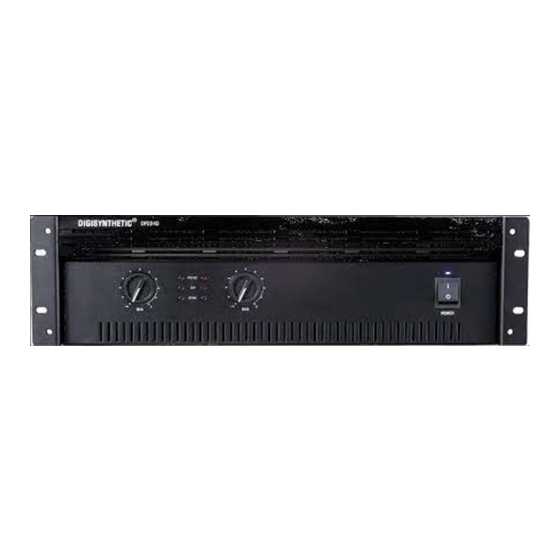DIGISYNTHETIC DP Series Gebruikershandleiding - Pagina 8
Blader online of download pdf Gebruikershandleiding voor {categorie_naam} DIGISYNTHETIC DP Series. DIGISYNTHETIC DP Series 13 pagina's. Excellent power amplifier
Ook voor DIGISYNTHETIC DP Series: Gebruikershandleiding (11 pagina's)

3. Connect the input and output cables as shown in the Only channel input is used.
4. Turn on the amplifier and adjust both level controls.
CAUTION: Never strap the two red output terminals together (in parallel). Never
connect either red output terminal to chassis ground.
IMPORTANT: The channel 2 level control will remain illuminated when operating in
Parallel/M-ono mode.
4.3
Additional Load Protection
To protect against excessive power, a fuse can be added in series with each
loudspeaker cable. A single fuse can protect the entire system, or can be used for each
driver. High frequency drivers (tweeters) are usually more sensitive to large voltage
peaks, while low-frequency drivers (woofers) are typically most sensitive to the heat from
average RMS output power. To protect your tweeters, we recommend that you use a
high-speed instrument fuse like the Little fuse 361000 series. To protect your woofers,
we recommend using a slow-blow fuse that more closely represents the thermal
response of your woofer. Use Figure 2-6 to find the correct value for either type of fuse.
4.4
RequiredAC Mains
All DP Series amplifiers are shipped with an appropriate line cord and plug. When
possible, use a power receptacle on a dedicated circuit; and always, make sure it will
provide the correct voltage and sufficient current. We do not recommend operating your
amplifier with voltages greater than 10% above or below the unit's rated voltage. For
example, if your amplifier is rated for 220 VAC, the line voltage should not exceed 240
VAC.
CAUTION: Connect unit only to a proper supply. Use only three wire cord which is
provided with unit.
5.operating instruction
5.1 Precautions
Although your amplifier is protected from external faults, the following safety precautions
are recommended:
1. There are important differences among the Stereo, Bridge-Mono and Parallel-Mono
operating modes. Please refer to Section 2 for additional information.
2.
WARNING Do not change the position of the stereo/mono switch unless the
:
amplifier is first turned off .
CAUTION: Never strap the two red output terminals together (in parallel). Never
connect either red output terminal to chassis ground.
Also, make sure the Stereo/Mono switch is set to the proper position.
3. Use care when making connections, selecting signal sources and controlling the
output level.
Page 7
